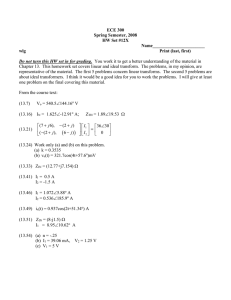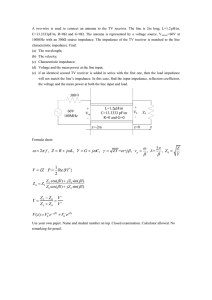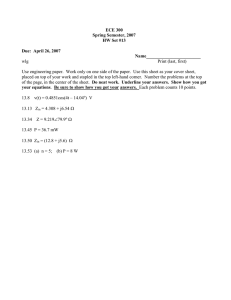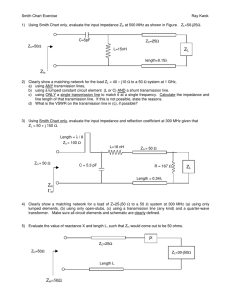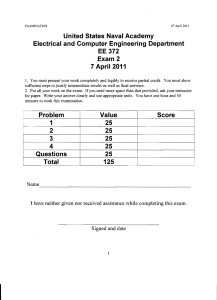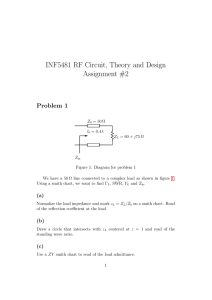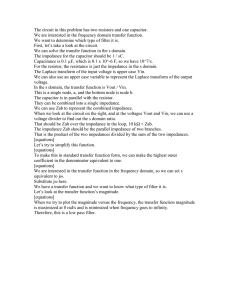Lecture 6: Impedance (frequency dependent resistance in the s
advertisement
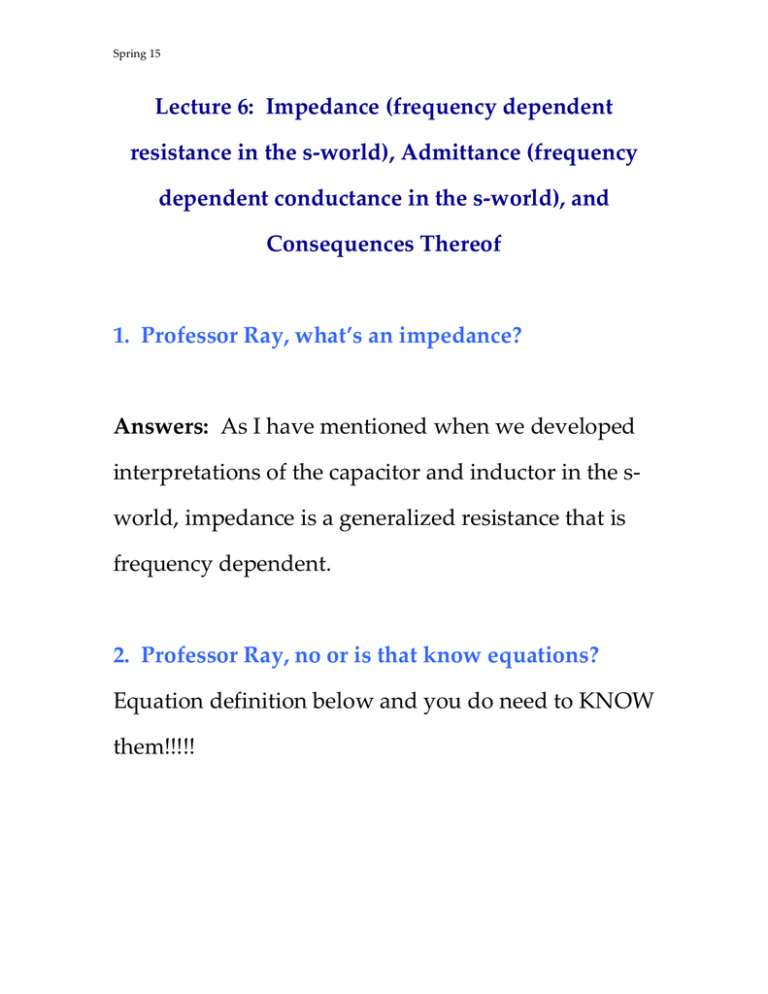
Spring 15 Lecture 6: Impedance (frequency dependent resistance in the s-­‐‑world), Admittance (frequency dependent conductance in the s-­‐‑world), and Consequences Thereof 1. Professor Ray, what’s an impedance? Answers: As I have mentioned when we developed interpretations of the capacitor and inductor in the s-­‐‑ world, impedance is a generalized resistance that is frequency dependent. 2. Professor Ray, no or is that know equations? Equation definition below and you do need to KNOW them!!!!! Spring 15 1. Definition. Impedance, denoted Zin (s) , in the s-­‐‑ world, and only in the s-­‐‑world, forever and ever and ever, in the total absence of initial conditions, is (i) Zin (s) = Vin (s) , or more generally I in (s) (ii) Vin (s) = Zin (s)I in (s) which avoids all that division by zero stuff. Admittance, Yin (s) . The inverse of impedance, i.e., Yin (s) = 1 1 . Clearly Zin (s) = . Zin (s) Yin (s) 2. Resistor Impedance/Admittance. Remember back in the good old days of 201 when resistors, denoted R, Spring 15 were resistors and Ohm’s law, V = RI , was Ohm’s law in the time world. They were the good old days when class was easy. And now, after taking Laplace transforms: V (s) = R I(s) ! Z R (s) I(s) and I (s) = 1 V (s) ! YR (s) V (s) R Remark: Looks the same as in the time world and so it is. Some things never change. Most do. 3. Capacitance Impedance/Admittance. dvC dt (i) t-­‐‑world: iC = C (ii) s-­‐‑world: IC (s) = Cs VC (s) ! YC (s) VC (s) or equivalently, in the usual Ohm’s law form: VC (s) = 1 IC (s) ! ZC (s) IC (s) Cs Spring 15 Remarks: 1. Now this is different. ZC (s) = 1 is an s-dependent resistance Cs that makes up an s-dependent Ohm’s law. Most things never stay the same. Some do. 2. At s = 0, the impedance (generalized resistance) of the capacitor is infinite meaning the capacitor looks like an open circit, meaning that 0-frequency current, which is dc, does not get through. 3. Inductance Impedance/Admittance. diL (i) t-­‐‑world: v L = L dt Spring 15 (ii) s-­‐‑world: VL (s) = Ls I L (s) ! Z L (s) IC (s) which is in the usual Ohm’s law form, and its admittance converse I L (s) = Remarks: 1. 1 VL (s) ! YL (s) VL (s) Ls Z L (s) = Ls is an s-dependent resistance that makes up an s-dependent Ohm’s law. Wow, really cool. Can’t wait to tell my date next weekend; being in lower case ee (elementary education) he/she is going to be so excited. 2. At s = 0, the impedance (generalized resistance) of the inductor is zero meaning the inductor looks like a short circuit, meaning that 0-frequency current, which is dc, goes right through like an Ipass toll booth. Spring 15 4. Manipulation RULES, i.e., the rules that govern the manipulation of Z and Y. Rule 1. Impedances (generalized resistances) are manipulated like resistances. Series LC circuit: Zcircuit (s) = Ls + 1 . Cs Rule 2. Admittancs are manipulated like conductances. Parallel RC circuit: Ycircuit (s) = Cs + 1 . R Product Rule: if Z1(s) and Z2 (s) are two impedances in parallel, then Spring 15 Zeq (s) = = 1 = Y1(s) + Y2 (s) 1 1 1 + Z1(s) Z2 (s) Z1(s)Z2 (s) Product = Z1(s) + Z2 (s) Sum Multi-­‐‑Parallel Admittance Rule: Zeq (s) = 1 Y1(s) + Y2 (s) + ...+ YN (s) Multi-­‐‑Parallel Impedance Rule: Zeq = Z1 + Z2 + ...+ Z n Remark: all other 201 rules apply. Use them. Spring 15 Rule 3. Ohm’s Law: V (s) = Z(s)I (s) or I (s) = Y (s)V (s) . 5. Series Circuits and Voltage Division Example 1. Consider the circuit below. (i) Zin = Z3 + Z4 (ii) Vout = Z4 V (Voltage Division) Z3 + Z4 in (iii) I out = Vin Vin = (Ohm’s law) Zin Z3 + Z4 Example 2. Find the input impedance seen by the source. Assume all parameter values are 1. Spring 15 1 R2 Ls 1 s Cs Zin (s) = + = + = 1 1 R2 + Ls s + 1 s + 1 R1 + Cs R1 6. Parallel Circuits and Current/Voltage Division Example 3. Consider the circuit below Spring 15 (i) Yout = 1 Z3 + Z 4 (ii) Yin = Y1 + Y2 + Yout (iii) Zin = 1 Y1 + Y2 + Yout (iv) I out = Yout Yout I in = I in (Current Division) Yin Y1 + Y2 + Yout (v) Vout = Z4 I out (Ohm’s law) Example 4. Find the input admittance and impedance of the circuit below. Suppose L = 1 H, C = 0.5 F, and R1 = R2 = 1 Ω. Also, find I out (s) . Spring 15 s 1 R2 1 1 L Part 1. Yin (s) = + = + 1 R 1 R1 + Ls R2 + s+ 1 s+ Cs R2C L 1 s s2 + 2s + 2 = + = s + 1 s + 2 (s + 1)(s + 2) Hence, Zin (s) = (s + 1)(s + 2) 2 2 (s + 1) + 1 Part 2. By current division, 1 s+2 I out (s) = 2 s + 1 I in (s) = 2 I in (s) s + 2s + 2 s + 2s + 2 (s + 1)(s + 2) 7. The 201/202 Twins: Thevenin and Norton (a) The equation of a Thevenin equivalent below is: Vin (s) = Zth (s)I in (s) + Voc (s) Spring 15 (b) The Norton equivalent equation is: I in (s) = Yth (s)Vin (s) − I sc (s) Relationship: Given I in (s) = Yth (s)Vin (s) − I sc (s) we can rearrange and divide by Yth (s) : Vin (s) = 1 1 I in (s) + I sc (s) Yth (s) Yth (s) or equivalently Vin (s) = Zth (s)I in (s) + Voc (s) Spring 15 where Voc (s) = Zth (s)I sc (s) . Example 6. Find the Thevenin equivalent of the circuit below. We first find the Norton equivalent and then convert to the Thevenin form. (a) I in = IC − I s (b) IC = Cs ⎡⎣Vin − α IC ⎤⎦ implies IC = Cs Vin . α Cs + 1 (c) Therefore, the Norton equivalent is: I in (s) = Cs V (s) − I s (s) = Yth (s)Vin (s) − I s (s) α Cs + 1 in (d) Equivalently, Spring 15 Vin (s) = α Cs + 1 α Cs + 1 I in (s) + I s (s) Cs Cs = Zth (s)I in (s) + Voc (s) Here: Voc (s) = Zth (s)I sc (s) .
